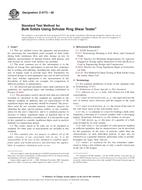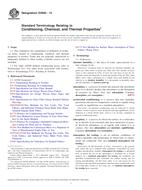Potrebujeme váš súhlas na využitie jednotlivých dát, aby sa vám okrem iného mohli ukazovať informácie týkajúce sa vašich záujmov. Súhlas udelíte kliknutím na tlačidlo „OK“.
ASTM D6773-08
Standard Shear Test Method for Bulk Solids Using the Schulze Ring Shear Tester
Automaticky preložený názov:
Štandardná šmyku Skúšobná metóda pre sypké hmoty s použitím Schulze Ring šmyku Tester
NORMA vydaná dňa 1.10.2008
Informácie o norme:
Označenie normy: ASTM D6773-08
Poznámka: NEPLATNÁ
Dátum vydania normy: 1.10.2008
Kód tovaru: NS-36475
Počet strán: 27
Približná hmotnosť: 81 g (0.18 libier)
Krajina: Americká technická norma
Kategória: Technické normy ASTM
Kategórie - podobné normy:
Anotácia textu normy ASTM D6773-08 :
Keywords:
bulk solid, effective angle of friction, effective yield locus, flow function, flowability, Jenike Shear Cell, internal friction angle, kinematic wall friction angle, powder, Schulze Ring Shear Tester, translational shear tester, unconfined yield strength, wall friction, Bulk solids, Effective angle of friction, Effective yield locus, Flow function, Internal friction testing, Jenike shear cell, Kinematic wall friction angle, Schulze ring shear tester, Translational shear tester
Doplňujúce informácie
| Significance and Use | ||||||||||||
|
Reliable, controlled flow of bulk solids from bins and hoppers is essential in almost every industrial facility. Unfortunately, flow stoppages due to arching and ratholing are common. Additional problems include uncontrolled flow (flooding) of powders, segregation of particle mixtures, useable capacity which is significantly less than design capacity, caking and spoilage of bulk solids in stagnant zones, and structural failures. By measuring the flow properties of bulk solids, and designing bins and hoppers based on these flow properties, most flow problems can be prevented or eliminated (1). For bulk solids with a significant percentage of particles (typically, one third or more) finer than about 6 mm ( ¼ in.), the unconfined yield strength is governed by the fines (−6 mm fraction). For such bulk solids, strength and wall friction tests may be performed on the fine fraction only. This test method covers operation of the manually-controlled Schulze Ring Shear Tester. An automated version of this tester is also available. Its method of testing bulk solids is similar in principle to that described in this test method. Note 1—The quality of the result produced by this standard is dependent on the competence of personnel performing it, and the suitability of the equipment and facilities used. Agencies that meet the criteria of Practice D 3740 are generally considered capable of competent and objective testing/sampling/inspection/etc. Users of this standard are cautioned that compliance with Practice D 3740 does not in itself assure reliable results. Reliable results depend on many factors; Practice D 3740 provides a means of evaluating some of those factors. Practice D 3740 was developed for agencies engaged in the testing or inspection (or both) of soil and rock. As such it is not totally applicable to agencies performing this standard. However, users of this standard should recognize that the framework of Practice D 3740 is appropriate for evaluating the quality of an agency performing this standard. Currently there is no known qualifying national authority that inspects agencies that perform this standard. |
||||||||||||
| 1. Scope | ||||||||||||
|
1.1 This test method covers the apparatus and procedures for measuring the unconfined yield strength of bulk solids during both continuous flow and after storage at rest. In addition, measurements of internal friction, bulk density, and wall friction on various wall surfaces are included. 1.2 The most common use of this information is in the design of storage bins and hoppers to prevent flow stoppages due to arching and ratholing, including the slope and smoothness of hopper walls to provide mass flow. Parameters for structural design of such equipment may also be derived from this data. Another application is the measurement of the flowability of bulk solids, for example, for comparison of different products or optimization. 1.3 All observed and calculated values shall conform to the guidelines for significant digits and rounding established in Practice D 6026. 1.3.1 The procedures used to specify how data are collected/recorded or calculated in this standard are regarded as the industry standard. In addition, they are representative of the significant digits that generally should be retained. The procedures used do not consider material variation, purpose for obtaining the data, special purpose studies, or any considerations for the user’s objectives: and it is common practice to increase or reduce significant digits of reported data to be commensurate with these considerations. It is beyond the scope of this standard to consider significant digits used in analysis methods for engineering design. 1.4 The values stated in SI units are to be regarded as standard. No other units of measurement are included in this standard. 1.5 This standard does not purport to address all of the safety concerns, if any, associated with its use. It is the responsibility of the user of this standard to establish appropriate safety and health practices and determine the applicability of regulatory limitations prior to use. |
||||||||||||
| 2. Referenced Documents | ||||||||||||
|
Podobné normy:
Historická
1.6.2012
Historická
1.7.2013
Historická
1.6.2010
Historická
1.12.2012
Historická
1.6.2013
Historická
1.1.2011



 ASTM D4848-98(2012)..
ASTM D4848-98(2012).. ASTM D4920-13
ASTM D4920-13 ASTM D5253-04(2010)e..
ASTM D5253-04(2010)e.. ASTM D5426-12
ASTM D5426-12 ASTM D5548-13
ASTM D5548-13 ASTM D5591-04(2011)..
ASTM D5591-04(2011)..
 Cookies
Cookies
